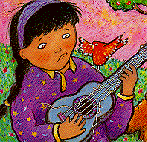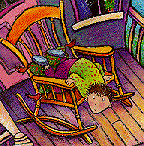

![]()

|
Two Too Many.
Jo Ellen Bogart. Illustrated by Yvonne Cathcart. Subject Headings:
Kindergarten - grade 2 / Ages 5 - 7.
**/4
|
excerpt:
Reginald had two too many rockers on his chair. Madeleine had two too many saddles on her mare. Eleanora's elephant had two too many knees. Susan's Mississippi had two too many "P"'s.
 Jo Ellen Bogart has written a counting book of sorts in Two Too Many. She makes her home in Guelph, Ontario and has published several children's books, among them Gifts, Mama's Bed, Sarah Saw a Blue Macaw, and Malcolm's Runaway Soap.
Jo Ellen Bogart has written a counting book of sorts in Two Too Many. She makes her home in Guelph, Ontario and has published several children's books, among them Gifts, Mama's Bed, Sarah Saw a Blue Macaw, and Malcolm's Runaway Soap.

Not recommended.
Leslie Millar is a substitute teacher and volunteer in Winnipeg schools.
To comment on this title or this review, send mail to cmeditor@mts.net.
![]()
Copyright © 1996 the Manitoba Library Association.
Reproduction for personal use is permitted only if this copyright notice
is maintained. Any other reproduction is prohibited without permission.
Published by
The Manitoba Library Association
ISSN 1201-9364
![]()